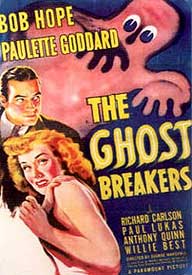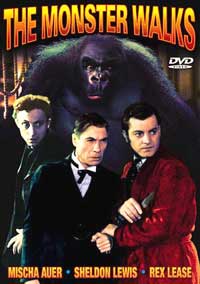The Monster Walks (1932) is a trivial thriller with a trivial cast, set in a spooky house on A Dark & Stormy Night, & populated by stock characters: the beautful young woman who has inherited her father's estate, her boyfriend, an uncle who will inherit everything if the woman is killed in the night, the uncle's angry bastard son who lives as a servant to the house, & of course, an ape in the basement.
Usually the menacing ape in the basement is a gorilla or, rather, a man in a gorilla outfit. This time it's a chimpanzee in a cage with no evidence of food, water, or space to exercise, & he's never once shown outside the cage. Now in real life it is true that a chimp can be pretty dangerous but in movie terms a chimp in a cage in the basement is no substitute for a big gorilla, for which reason the illustration on the dvd box (reproduced above) shows a gorilla rather than what's actually in the film.
Every time something untoward happens in the dark house, everyone has to go see if the chimp is still in its cage, & it always is, but nobody suspects the actual villain (or villains) who are vastly more apt to require scrutiny.
At some point during production someone on the set must have asked why is there a chimpanzee in the basement, & a bit of dialogue was tacked on to the end where the eye-rolling frightened black chauffeur is informed it's because the late owner of the house believed in Darwin's theory that humans are descended from monkeys. The black chauffeur has the last scene of the film, & confesses that his African family certainly does look like chimpanzees.
For sociological reasons the film's greater interest is this black actor who accepted one of the more demeaning of demeaning roles. He's a young Willie Best, who probably felt lucky to have a role with more lines than "Yes suh" in it. His character's name is Exodus because he's always running away. The credits allege that his real name is "Sleep 'n' Eat," akin to Lincoln Theodore Perry who became internationally famous as "Stepin Fetchit."
It would be strange even for 1932 if nobody found it appalling to see a black character who claims his family looks like chimps & who gets shoved around even by the house servants since they're white. Such roles were questioned in the day, often by the black character actors themselves.
 Willie Best specialized in being the shufflin' porter, chauffeur, men's room attendant, or waiter full of fear & superstition, but it is important to note that this character originated in African American humor & was originally presented as a character of surprising intelligence tricking whites into thinking he was too lazy & stupid to be useful as a slave, & "jive" talk originated as a way of insulting the "marse" or master while seeming to be only an imbecile. As filtered through white comedy writers, alas, it meant only that negroes were childishly superstitious & rightly the butt of fun. Willie Best specialized in being the shufflin' porter, chauffeur, men's room attendant, or waiter full of fear & superstition, but it is important to note that this character originated in African American humor & was originally presented as a character of surprising intelligence tricking whites into thinking he was too lazy & stupid to be useful as a slave, & "jive" talk originated as a way of insulting the "marse" or master while seeming to be only an imbecile. As filtered through white comedy writers, alas, it meant only that negroes were childishly superstitious & rightly the butt of fun.
Though his talent was abused, Willie Best was nevertheless a fine comic actor, & it was Willie rather than his contemporary Stepin Fetchit who came up with the immortal line "Feets don't fail me now" in The Ghost Breakers (1940).
Ghost Breakers was a comparatively funny & effective if standard bit of Old Dark Castle comedy with Willie as Bob Hope's funnier-than-bob-hope servant. How I'd love to go back in time & direct a comedy starring Willie as a wealthy Ethiopian playboy detective & Bob Hope as his easily frightened Man Friday. It'd perhaps have Josephine Baker instead of Paulette Goddard as leading lady.
I'd sure keep Noble Jackson as the zombie, for even if that role is also a little racist, Noble's nevertheless f'ing scary cool.
copyright © by Paghat the Ratgirl
|

 Willie Best specialized in being the shufflin' porter, chauffeur, men's room attendant, or waiter full of fear & superstition, but it is important to note that this character originated in African American humor & was originally presented as a character of surprising intelligence tricking whites into thinking he was too lazy & stupid to be useful as a slave, & "jive" talk originated as a way of insulting the "marse" or master while seeming to be only an imbecile. As filtered through white comedy writers, alas, it meant only that negroes were childishly superstitious & rightly the butt of fun.
Willie Best specialized in being the shufflin' porter, chauffeur, men's room attendant, or waiter full of fear & superstition, but it is important to note that this character originated in African American humor & was originally presented as a character of surprising intelligence tricking whites into thinking he was too lazy & stupid to be useful as a slave, & "jive" talk originated as a way of insulting the "marse" or master while seeming to be only an imbecile. As filtered through white comedy writers, alas, it meant only that negroes were childishly superstitious & rightly the butt of fun.